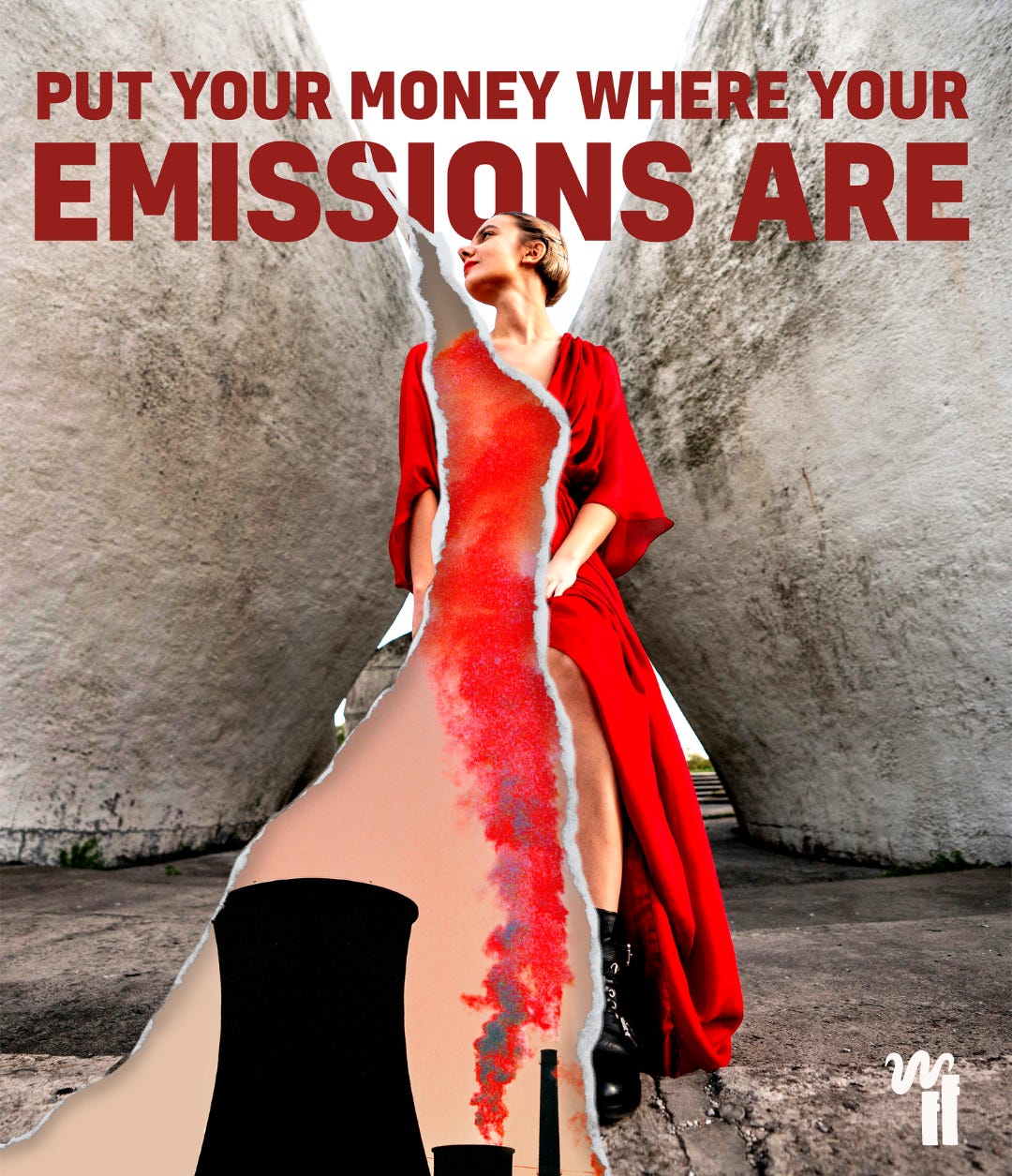This morning I joined my ex-colleagues at Fashion Revolution in London as they launched the brand new What Fuels Fashion report. A culmination of 10 months of intense research and analysis, I was delighted to contribute to developing the methodology of this special edition of the annual Fashion Transparency Index which dives deep into the fashion industry’s decarbonisation efforts (or lack thereof).
I am genuinely thrilled to see this project bloom from the small seed of an idea we discussed over lunch one day last summer. Huge congratulations to the team for a successful launch, and I can’t wait to see how the What Fuels Fashion campaign grows.
Scroll on to explore some key findings from the report and to read my viewpoint on the crucial importance of transparency for an effective green transition in the fashion supply chain.
Key findings
Of 250 brands and retailers reviewed (all of which have an annual turnover of at least $400million USD)….
The top scorers were sportswear brand Puma (75%), luxury brand Gucci (74%) and high street brand H&M (61%), while an appalling 60 brands scored 0%, including high fashion’s Tom Ford, athleisure leader Fabletics and fast fashion brand Fashion Nova. The overall average score was 18%.
Nearly a quarter of the world’s biggest fashion brands disclose nothing on decarbonisation, while only four out of 250 have emissions reduction targets that meet the level of ambition called for by climate scientists.
At least 42 brands report increased scope 3 emissions against their baseline year, which undoubtedly is related to the majority of companies lacking targets on coal phase-out and renewable energy for their supply chains.
Just 10% of brands disclose information about their energy procurement, allowing false solutions like unbundled RECs, carbon offsets and unsustainable biomass to dominate, and failing to meaningfully contribute to grid decarbonisation.
89% of brands do not disclose how many clothes they make annually, while just 2 brands make a commitment to degrowth (reducing absolute production volumes).
More than half the brands have sustainable material targets but only 11% reveal their supply chain’s energy sources, meaning so-called ‘sustainable’ products could still be produced using fossil fuels in manufacturing, where the majority of a product’s carbon footprint originates.
94% of brands fail to disclose how much they are investing in supply chain decarbonisation, while just 13% of brands disclosed evidence of renewable energy advocacy in their supply chain regions.
Recommendations
Brands must invest at least 2% of their revenues into a just energy transition, ideally through a shared Fair Climate Fund (this is a conservative estimate based on credible calculations, and would ideally be topped up by supplier contributions and blended finance from banks, development organisations and other investors). Maeve Galvin, Global Policy and Campaigns Director at Fashion Revolution, explains:
"By investing at least 2% of their revenue into clean, renewable energy and upskilling and supporting workers, fashion could simultaneously curb the impacts of the climate crisis and reduce poverty and inequality within their supply chains. Climate breakdown is avoidable because we have the solution - and big fashion can certainly afford it.”Brands must set robust short and long term targets for the reduction of scope 3 absolute emissions, including a target for phasing out coal and detailed decarbonisation plans. Brands should also commit to 100% renewable energy (wind and solar) in the supply chain by 2030 and help accelerate this by advocating for policymakers in garment-producing and importing countries to enable access to high-quality renewable energy.
Other stakeholders, including policymakers, investors, shareholders, journalists, academics and civil society, should use the research to scrutinise brands’ claims in order to hold them accountable and incentivise good practice.
Citizens can take action to demand that major brands and retailers put their money where their emissions are using this simple email-a-brand tool.
Some more interesting nuggets
The climate crisis clock is ticking and we cannot afford to waste time determining chains of responsibility. But supply chain traceability remains poor, with just 52% of brands disclosing their Tier 1 suppliers, 34% disclosing processing facilities, and 8% disclosing raw materials.
The recommendations for financing decarbonisation follow the Polluter Pays principle, meaning those responsible for the biggest contribution to greenhouse gas emissions should be responsible for the biggest financial contribution to mitigating them. It also means that financing should be proportionate to turnover and ability to pay, which translates to multi-billion dollar fashion brands supporting their suppliers, often SMEs, who create their value in the first place.
Relatedly, decision-making should also be shared across the value chain, with suppliers holding the most relevant contextual expertise for developing effective decarbonisation strategies. Suppliers and worker representatives should be consulted and engaged in constructive dialogue to ensure climate targets and plans for achieving them are carried out fairly, feasibly and effectively.
The majority of financing solutions currently available to suppliers are debt-based and incentivise low-hanging fruit like energy efficiency rather than high CapEx projects like electrification of thermal processes. This not only hampers carbon reduction potential but can burden suppliers with loans to meet brands’ climate targets, and ultimately perpetuates existing power imbalances. Long-term investment is key to decarbonising fashion’s supply chains, including building long-term supplier relationships through fair purchasing practices, grant-based funding and contract incentives.
Executives at fashion brands are not sufficiently incentivised to act on climate, with just 18% of brands disclosing how executive pay and bonuses are linked to climate targets. Carbon pricing could be one mechanism to help shift this system, but currently, just 9% of brands say they use an internal carbon price to guide decision-making. Environmental harm must no longer be externalised by companies and should be penalised in the same way financial losses are at the C-suite level.
Because climate change is already impacting workers and communities across the fashion supply chain, adaptation must be on the industry’s radar in addition to mitigation. However, the report found that only 3% of brands disclose efforts to
financially compensate workers affected by the impacts of the climate crisis and 6% disclose how they engage with workers, local communities, and other affected
stakeholders to co-create local solutions.
Without reducing absolute production volumes, we are highly unlikely to sufficiently reduce carbon emissions in line with 1.5-degree pathways. But currently, many brands are setting intensity-based targets, meaning emissions can still increase as production volumes grow. Brands must set absolute emissions reduction targets and find ways to create value other than virgin resource use, wasteful and excessive overproduction and manufacturing demand for overconsumption.
Multi-stakeholder initiatives, certification schemes, lobby groups and other collaborative projects can risk offering safe harbours for inaction to fashion brands. For example, the report found that many brands claim to have a coal phaseout plan by dint of being signatories to the UN Fashion Charter but have failed to disclose any kind of target under their own name. I’ve previously spoken about this issue here and here.
RECs (renewable energy credits/certificates) are increasingly being shown as unlikely to contribute to meaningful decarbonisation, yet many fashion brands rely heavily on unbundled RECs (ie. no direct link between renewable energy generation and consumption) to claim they run their operations and supply chain on renewables. Without contributing to additional renewable energy capacity, such as through onsite solar panels or PPAs (power purchase agreements) from offsite solar and wind infrastructure, and without matching the renewable energy generation to consumption on a 24/7 basis, the credibility and integrity of decarbonisation claims remain unclear.
It’s not just fashion - CDP just revealed that only 15% of corporates across multiple sectors have set a supply chain emissions target despite (or because of) these emissions being 26x higher than their own operations on average.
Finally, the best quote of the morning: “This isn’t a question of feasibility. It’s a matter of willpower.” The green transition is scientifically sound and brands can afford it. The time to act is now.
Hidden data is delaying progress on climate action
By Ruth MacGilp, Fashion Campaign Manager at Action Speaks Louder
Climate scientists are increasingly alarmed by just how quickly climate models are being outpaced by record-breaking temperatures and extreme weather events. Even the most optimistic predictions risk being surpassed as we smash through six out of nine planetary boundaries and already exceed 1.5°C of global heating.
How could this be? In part, it is because we really don’t know the true scale of our global carbon footprint, due to a system of mostly voluntary, unregulated emissions accounting.
Several calculations have attempted to estimate the fashion industry’s emissions, largely based on incomplete fibre production data, ranging from 1.8% to 4.6% to 8-10% of the whole economy. But as this report shows, almost half of brands do not even disclose their Scope 3 emissions. There are also huge gaps in our understanding of fashion’s climate impact because of the top-down nature of the sector, where supply chain emissions data is largely based on secondary averages pulled from flawed lifecycle analysis (LCA) studies. Meanwhile, brands only report emissions from products that reach the shop floor, leaving cancelled orders as ghosts in the machine.
Out of the 117 brands that disclosed science-based targets, 42 have reported an increase in their scope 3 emissions compared to their baseline year. What’s more, 24% of brands disclosed absolutely nothing about their decarbonisation plans, and most brands failed to commit to phasing out coal, electrifying thermal processes or transitioning to renewable energy. As the Intergovernmental Panel on Climate Change (IPCC) recommends, emissions of all sectors must halve by 2030 to mitigate the most catastrophic climate impacts—which are already being experienced by communities and workers in brands’s own supply chains—so we must call out these major brands for their climate inaction, just like the fossil fuel companies they rely on.
So much of the problem, and therefore the solution, lies with the rules of the game - aka the non-binding nature of emissions disclosure and decarbonisation plans. Accounting loopholes, misleading reporting, corrupt funding and false solutions - like carbon offsets and renewable energy credits - dominate the corporate sustainability landscape. Certification schemes and multi-stakeholder initiatives provide smokescreens for inaction. PR-friendly promises are substitutes for implementation and investment. While I’m under no illusion that a corporate entity will have pure intentions for the challenging and expensive work of climate mitigation, integrity and transparency are essential to align with the harsh reality climate science is screaming at us.
It is positive to see tangible signs of progress in this year’s report, like a growing number of brands setting emissions reduction targets across all scopes. Time-bound, measurable targets are essential to driving investment, enabling accountability, and signalling change across the industry. Still, it’s difficult to celebrate these incremental improvements when emissions continue growing beyond an already sky-high baseline.
Looking forward, we need to see brands prioritise three actions. First, setting short and long-term targets aligned with a 1.5°C pathway. Second, developing credible, strategic roadmaps to meet these targets, including renewable energy procurement plans. Third, integrating the climate strategy into the business strategy by backing up these targets with financial investment— brands must provide substantial support and fairer purchasing practices for suppliers to access decarbonisation and ultimately address the short-term profit-driven fast fashion business model that drives overproduction and waste. Where should companies start? By publicly disclosing each of these steps.
For every sustainability claim we see, we need to ask one fundamental question. Does this actually make an impact on reducing emissions, ditching fossil fuels or scaling up renewable energy? If not, the Earth simply cannot tell the difference.
Thank you for reading Threadbare! Make sure to subscribe if you haven’t already.
I strongly encourage you to take a couple of hours to dive deeper into the What Fuels Fashion report to discover all of its rich takeaways. You can download it here.








Super interesting article! Thanks for sharing it☺️
Appreciate you ❤️